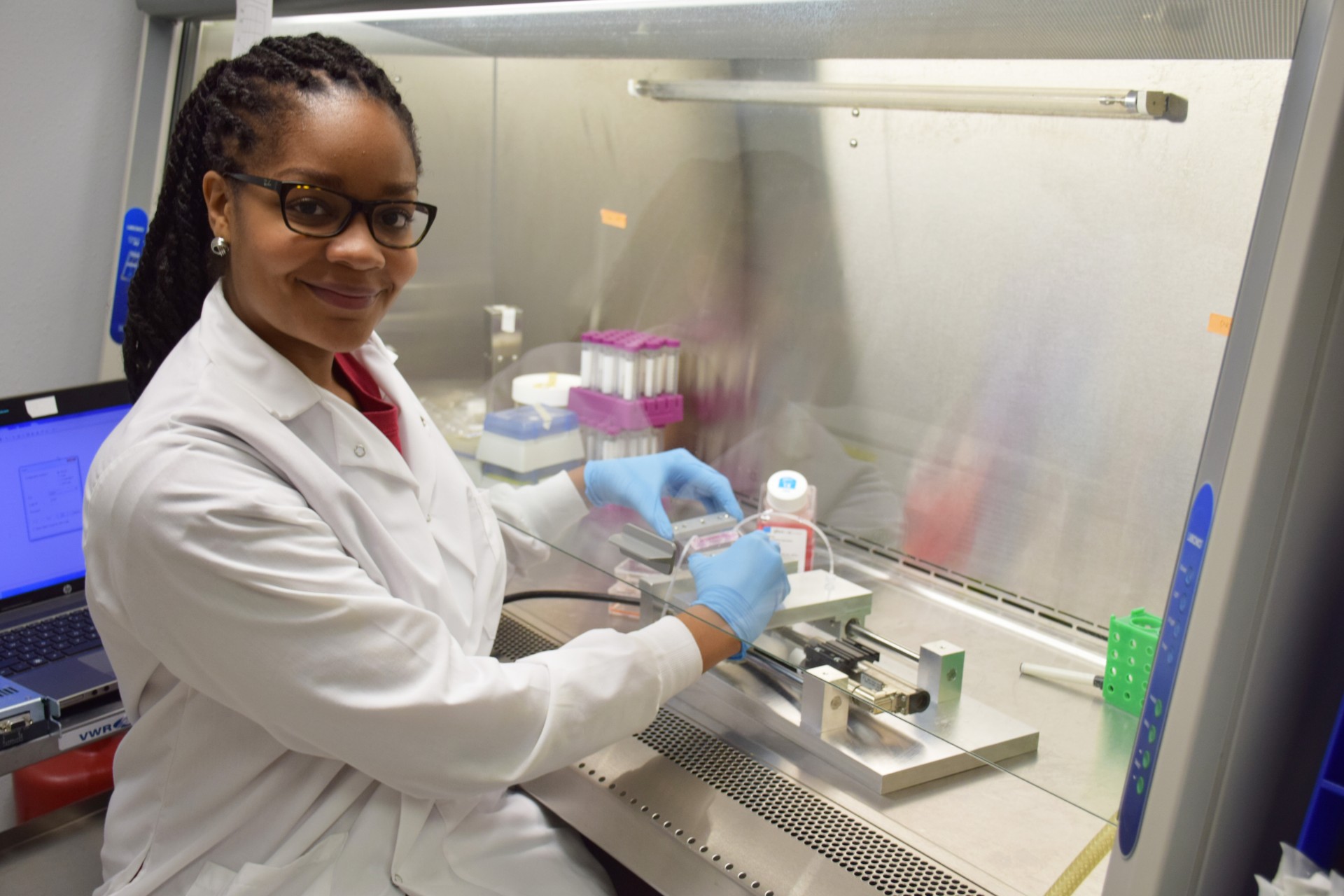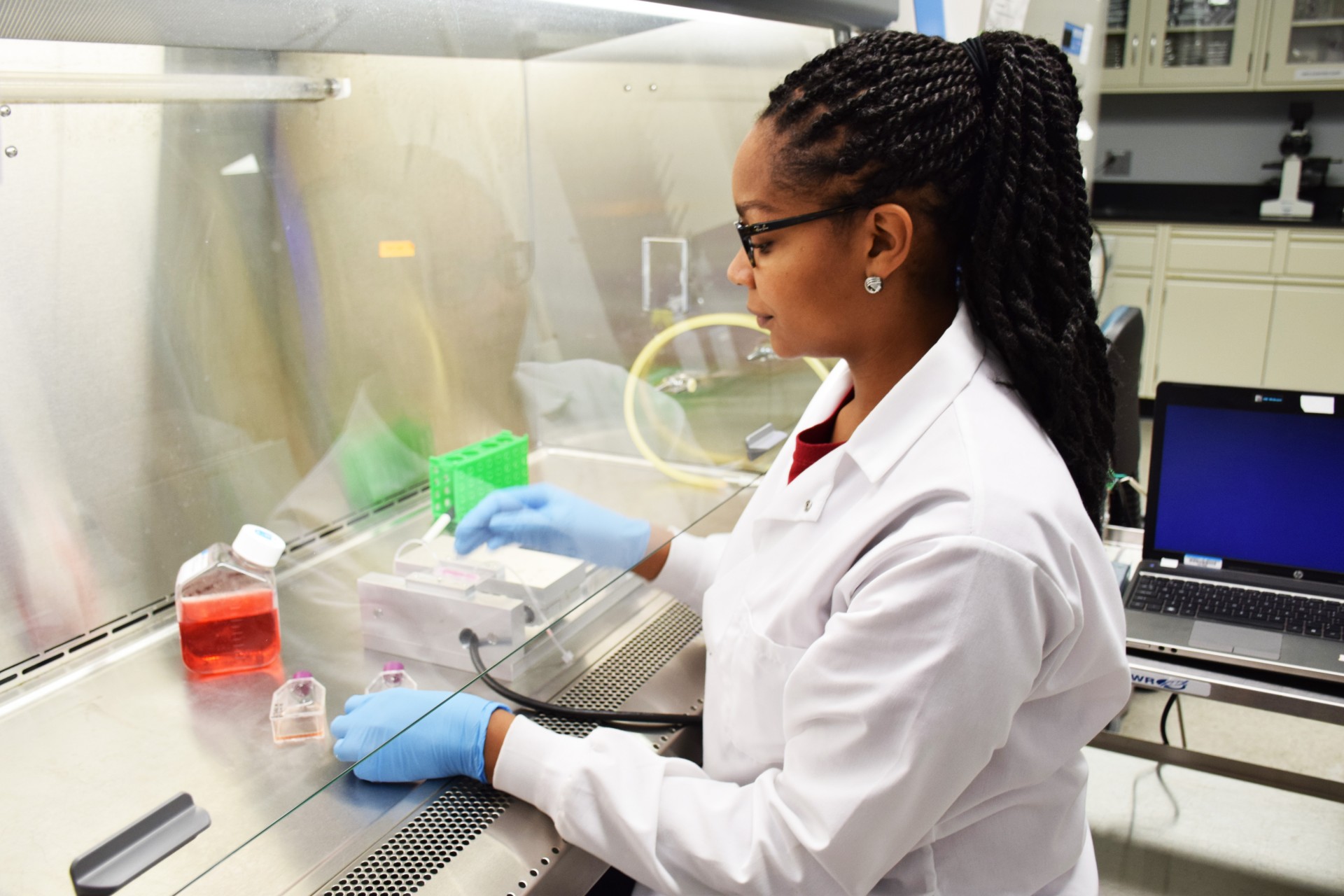Nasya Sturdivant is a doctoral student in biomedical engineering here at the U of A. She is presently at work building an effective synthetic blood-brain barrier that will help improve the treatment of traumatic brain injuries.
UArk BME: Did you always know you wanted to study biomedical engineering?
Sturdivant: I didn’t know I wanted to study biomedical engineering until my junior year in undergrad. A generation ago, the field of biomedical engineering wasn’t widespread. So it wasn’t a subject I grew up wanting to study. I did, however, know I wanted to be in a life sciences field and while in high school I gained interest in engineering and design. Researching a combination of the two is when I began to learn more about the emerging field of biomedical engineering.
UArk BME: You received your undergraduate degree from North Carolina A&T State University in Greensboro, NC. What made you choose the University of Arkansas for graduate school?
Sturdivant: The Department of Engineering at the U of A was very new when I joined. The exciting research interests of the faculty along with the extreme potential for growth of the department was a huge draw for me. I also had the opportunity to visit the university and the department before applying and I really meshed with Dr. Balachandran, my current advisor.
UArk BME: How will your research help to improve the treatment of traumatic brain injuries?
Sturdivant: It is my hope that my research project (the BBB-on-Chip) will one day be used as a tool to test the efficacy of potential pharmaceutical treatments to pass through the BBB and mitigate the secondary injuries of a traumatic brain injury (TBI), such as BBB breakdown, inflammation, swelling, and apoptosis.
UArk BME: Which faculty members have you worked most closely with in your research here? What has it been like working with them?
Sturdivant: Within my department I work most closely with Dr. Kartik Balachandran who is my research advisor and Dr. Jeff Wolchok. Both Dr. Balachandran and Dr. Wolchok’s labs have interest in TBI and tissue engineering. Working with Dr. Balachandran has been an amazing experience; he’s incredibly knowledgeable of a wide range of research subjects, he’s encouraging, and he pushes all of his students to their full potential. Dr. Wolchok is always willing to offer his expertise and honest advice on how to improve the impact of our research. I have also worked with Dr. Tung in the mechanical engineering department. His expertise in BioMEMs has been instrumental in the fabrication of my BBB-on-chip.
UArk BME: What’s a typical day like for you as a PhD student? How do you balance the demands of your research with your other responsibilities?
Sturdivant: Every day as a PhD student is different. Some days I’m doing lab work which includes running experiments, troubleshooting, and analyzing data. Some days I’m at my desk reading journal articles or writing. Some days I’m working on computational models using engineering software like Solidworks, AutoCAD and Comsol. I also take an active role in mentoring undergraduate students. Research is my main responsibility right now. However, it is very important to me that I balance my work life and social life. Making time to spend with friends and being active on campus in organizations such as the Black Graduate Student Association (BGSA) and the ASG Graduate Student Congress is what keeps me well-balanced.
UArk BME: You spent a month at the U.S. Food and Drug Administration’s National Center for Toxicological Research in Pine Bluff, AR. Can you explain how your experience there relates to your current research?
Sturdivant: I spent a month working under researchers and post docs in Dr. Syed Ali’s neurochemistry lab. During this time, I learned how to isolate microvascular endothelial cells (the cells that make up the BBB) from an adult rat brain. I also learned about different techniques to measure BBB integrity in vivo and in vitro. My research focuses mainly on in vitro models but I am excited to see what direction our lab will go in with in vivo studies under the direction of our new PhD student, Celeste Dunn. Celeste will be picking up the TBI research once I graduate. The experience also gave me insight into working in a government research lab.
UArk BME: What have the greatest challenges been in you research work so far? How have you overcome them?
Sturdivant: My greatest challenge has been the fabrication of an elastic porous membrane for my chip. The purpose of this membrane is to separate the astrocytes from the MvECs while still allowing for paracellular communication. The membrane needs to be thin, elastic (to withstand the high speed TBI stretch) and the pores need to be smaller than 5 microns (the cell size). Such a membrane is not commercially available so I have had to try many different methods and techniques to fabricate such a membrane. I was able to overcome this challenge by employing photolithographic, soft lithographic, and spincoating techniques.
UArk BME: What’s your favorite part of being a PhD student at the University of Arkansas?
Sturdivant: My favorite part about being a PhD student at the U of A is the access to the state of the art equipment and facilities at the High Density Electronics Center (HiDEC) and the Nanoscale Material Science & Engineering Building (Nano Building).
UArk BME: Any advice for undergrads studying biomedical engineering who are considering graduate school?
Sturdivant: My advice would be to (1) figure out your passion (ex: teaching, mentoring, engineering, patient interaction, etc.), (2) find a career that encompasses that passion (ex: becoming a physician, professor, working at a government agencies or in industry) and (3) see if graduate school is a good stepping stone to achieving your end goal. The main thing that will get you through the long hours and trials and errors of graduate research is the ability to stay motivated by knowing you are in active pursuit of your passion.



